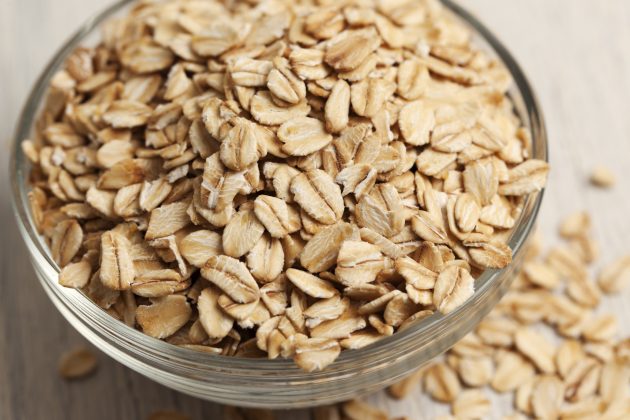
New opportunities for Canadian oats in the plant-based food sector
By Lilian Schaer for Canadian Food Innovation Network
Research & Development Plant-based foods Canadian Food Innovation Network Editor pick Oat protein Richardson International Photo © Creative99/Getty
Photo © Creative99/Getty More and more consumers around the world are looking for alternatives to animal-based proteins. That has sent interest in plant-based foods soaring and food manufacturers, eager to meet the growing demand, are turning to crops like peas and soy to develop new products.
For Richardson International, Canada’s largest agri-business and North America’s largest oat miller, the question became whether there could also be opportunities for oats in the plant protein food market. The company produces a variety of oat-based products, including oat groats, oat flakes, as well as granola-based products and oat flour.
Canada is the second largest oat producer the world, and oats are both healthy and easy to use in a wide range of applications from flakes to flours. To date, however, oat protein use has been limited because it’s difficult to extract and performs differently than other plant proteins in many applications. Its production also generates side stream products that have the potential to become waste.
“The food and beverage industry are using plant proteins as replacements for eggs or meat, for example, in ways they’ve never done before,” explains Steve Robbins, senior product development manager with Richardson International. “We don’t just want to sell commodity oats; we want to process oats and create extra value. We want to create an oat protein concentrate with functionality, for interesting applications, and be the go-to company for oat-based ingredients.”

Photo © Alleko/Getty
To find answers, Richardson received funding for a Canadian Food Innovation Network (CFIN) Emerging Science Research Cluster project. This let the company work with Dr. Rotimi Aluko, professor in the Department of Food and Human Nutritional Sciences at the University of Manitoba and Director of the Richardson Centre for Functional Foods and Nutraceuticals, and Alphonsus Utioh, manager of research and development at Manitoba’s Food Development Centre to address the oat protein question.
“We focused on the ability to produce a protein product from low bran oat flour. Low bran oat flour is of low value in the industry and is usually considered more like a waste product,” says Aluko. “We wanted to find a way the company could create a plant protein product from oats but at the same time increase the value of the oat bran flour.”
The two-year project included:
- Evaluating different oat flours and milling methods for oats to find the one most suitable for protein extraction
- Finding a new and better way to extract oat protein
- Determining the nutritional properties of the oat protein, the applications its most suited for and what the market would be for the new ingredient
- Scaling up the extraction process from the laboratory to a pilot plant scale to prepare it for commercialization
Aluko and the research team found a way to use a pure aqueous or water-based process to separate protein from non-protein components of the oats, like starch and bran, and extract it from the low bran oat flour.
“We started with low bran oat flour with 10 to 11 per cent protein and the outcome of the project was a protein product that had up to 60-70 per cent protein, so we have enriched the protein by almost seven times,” explains Aluko.
This type of protein product is called a protein concentrate, which is used by the food and beverage processing industry to manufacture various food products.
“It’s a viable ingredient and oat protein has some interesting properties that make it different from pea and soy proteins,” says Robbins, adding that its emulsification ability is superior to that of standard proteins, making oat protein an excellent ingredient for products like salad dressings or vegan mayonnaise.
The collaboration fostered by the cluster brought together the expertise of an academic researcher with a process engineer and a production scientist to develop a process that is now ready for commercialization. The financial support provided through the cluster was also invaluable in making this research happen.
“Without having the funding, this type of project becomes much more difficult to do and can be much more time-intensive if you don’t have that sort of funding support,” says Robbins.
The extraction process was successfully transferred from the lab to a pilot plant level and is now ready for commercialization. Important next steps include developing additional revenue streams from the by-products of the extraction process, in products like oat syrups for example.
Why is this innovation important?
- Creates new plant-based ingredient options for Canadian food and beverage processors
- Supports clean label product development
- Adds the health benefits of oats to new food and beverage products
What does this project mean to Canada’s food processing industry?
This technology opens up new ingredient options for Canada’s food and beverage processors looking to bring plant-based products to the market in response to growing consumer demand, while also bringing value to a product not currently widely used in the industry.
About Richardson International
Richardson International is Canada’s largest agribusiness and is recognized as a global leader in agriculture and food processing. In addition to owning a network of grain terminals in western Canada, the company is North America’s largest oat miller and as well as one of North America’s biggest canola crushers.
About the project team
Dr. Rotimi Aluko is a professor in the Department of Food and Human Nutritional Sciences at the University of Manitoba, where he also serves as director of the Richardson Centre for Functional Foods and Nutraceuticals. He holds a PhD in food chemistry with a focus on proteins from the University of Guelph and is a certified food scientist. He also has standing in numerous professional associations and serves as editor-in-chief of the Journal of Food Biochemistry.
Alphonsus Utioh is manager of research and development at the Food Development Centre in Manitoba. He’s also a professional engineer and serves as an adjunct professor in the Department of Human Nutritional Sciences at the University of Manitoba. He completed an undergraduate degree in chemical engineering at the University of Ottawa and a master’s degree in chemical engineering at the University of Saskatchewan.
Steven Robbins is senior product development manager with Richardson International. He holds an undergraduate degree in chemistry and a master’s degree in organic chemistry, both from the University of Lethbridge.
The Canadian Food Innovation Network Emerging Science Research Cluster is funded in part through the AgriScience Program under the Canadian Agricultural Partnership, a federal-provincial-territorial initiative. For more information, contact Laura Sider, science co-ordinator, CFIN.
Print this page